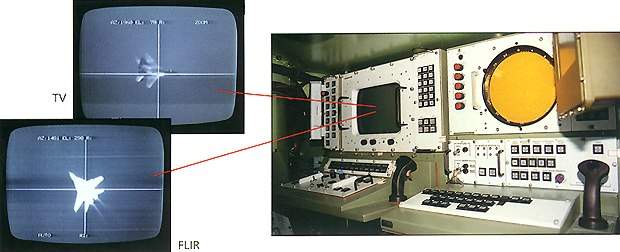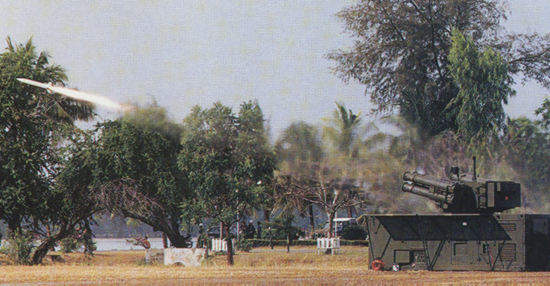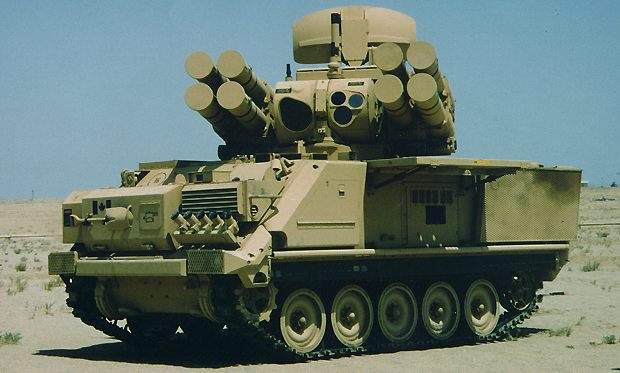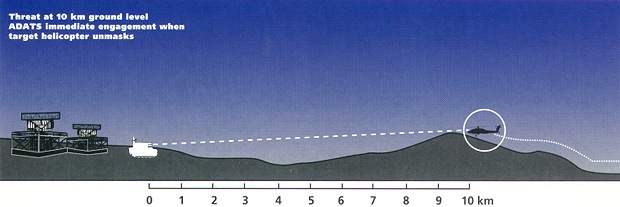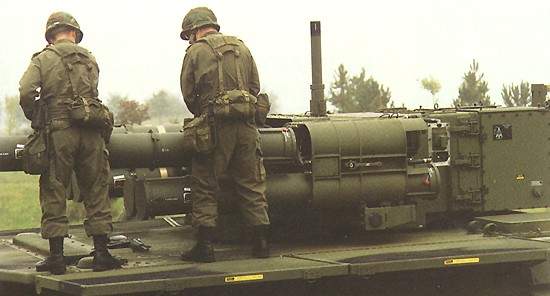
ADATS is a low-level short range air defence (SHORAD) system, capable of engaging both air and surface targets. It was manufactured by Oerlikon Contraves based in Zurich, Switzerland, now part of Rheinmetall Defence, and Oerlikon Aerospace in Quebec, which is now Rheinmetall Canada.
ADATS is in service as part of the Canadian Forces Low-Level Air Defence System (CF LLADS). The first system was delivered in 1988. 36 systems were delivered, ending in 1994. The Royal Thai Air Force has one shelter-based system, linked to a Skyguard fire control system.
The ADATS Missile System can be mounted on a variety of mobile platforms, such as the M113 and M3 Bradley.
For the Canadian CFLLADS, it is mounted on the M113 armoured vehicle. It is also available in a shelter-based version for fixed and in a palletised version, which can be integrated with the Oerlikon Contraves Skyshield Air Defence System.
ADATS MULTI-MISSION EFFECTS VEHICLE (MMEV)
In September 2005, the Canadian Forces announced the design and development of 33 Multi-Mission Effects Vehicles (MMEV), to be based on ADATS. The MMEV would combine anti-tank and air-defence capabilities on one platform and be able to engage ground targets such as armoured vehicles and bunkers, as well as aircraft, helicopters, unmanned aerial vehicles and cruise missiles. The vehicle was to be developed by the Canadian Forces with Rheinmetall Canada and Defence R&D Canada.
The MMEV was to be based on the existing ADATS turrets mounted on a General Dynamics Land Systems 8×8 LAV III vehicle, in service with the Canadian Army since 2001. As well as the ADATS missile, the MMEV would be able to fire a long-range anti-armour missile and a non-line-of-sight missile.
In November 2006, the Canadian Army cancelled the MMEV project.
ADATS COMMAND AND CONTROL
The ADATS network coordinates the fire power of up to six ADATS spaced at distances up to 20km. Any ADATS can be the network master controller and the network can link with other command facilities in real time.
Fully automatic real-time data exchange includes airspace control data, weapon control orders and fire control orders, target identification data, individual system status and vehicle position, threat prioritisation and optimised weapon allocation, engagement status, weapon status and jammer triangulation data.
The six-unit network can engage up to 48 air or ground targets.
The links use frequency-agile radios or landline. Over 2,000 frequencies with 25kHz channel spacing are used in the frequency agile radio link. The system architecture provides full duplex data exchange and simultaneous half duplex voice communications.
ADATS MISSILE
The ADATS missile can engage all types of low-level threats, including attack helicopters exposed at stand-off ranges at extremely low altitudes. The system has a 10km range against air or ground targets.
The missile has laser beamriding guidance and the laser guidance grid is digitally encoded for precision and immunity to countermeasures. It is equipped with smokeless boost-coast propulsion. The missile has a speed of over Mach 3 and manoeuvrability of 60g.
The missile has a laser fuse with variable fuse delay automatically set at missile launch. The combined fragmentation and shaped charge warhead weighs 12kg and has demonstrated penetration of over 900mm of Rolled Homogeneous Armour (RHA). A total of eight missiles are carried.
FIRE CONTROL AND SURVEILLANCE
The ADATS electro-optical systems for target tracking and missile guidance are supplied by Lockheed Martin Missiles and Fire Control and are based on an enhanced performance version of the Apache helicopter TADS/PNVS.
The Forward Looking Infra-Red (FLIR), based on the US common module and operating in the eight to twelve micron band, provides full operational capability in adverse weather. Other systems include a near infra-red vidicon television for day use, a carbon dioxide laser for missile guidance and a Neodinium YaG laser rangefinder operating at 1.06 microns.
The ADATS pulse doppler X-band dual-beam radar is used for target acquisition and identification and allows ADATS to operate autonomously. The radar is frequency agile and fully coherent. The ADATS radar can also assign targets to other ADATS in a command, control and communications network with their radars in silent mode.
The capability of the radar to operate in track-while-scan mode and the 20-target computer-aided threat evaluation in netted configuration, assist the operator in weapon allocation to highest priority threats. The system also has search-on-the move and sector search programming. Range is 25km to an altitude of 8,600m.
ENGAGEMENT SEQUENCE
Initial target detection to missile launch takes less than five seconds. The engagement sequence begins with target detection and turret slew using radar, FLIR and television systems against air targets and FLIR and television against ground targets. The tracker search and target acquisition sequence is carried out using the FLIR and the television sighting system.
Missile launch and guidance uses FLIR and television target tracking and carbon dioxide laser beam riding missile guidance. The time required to launch a second missile following completion of the first engagement is less than two seconds.



